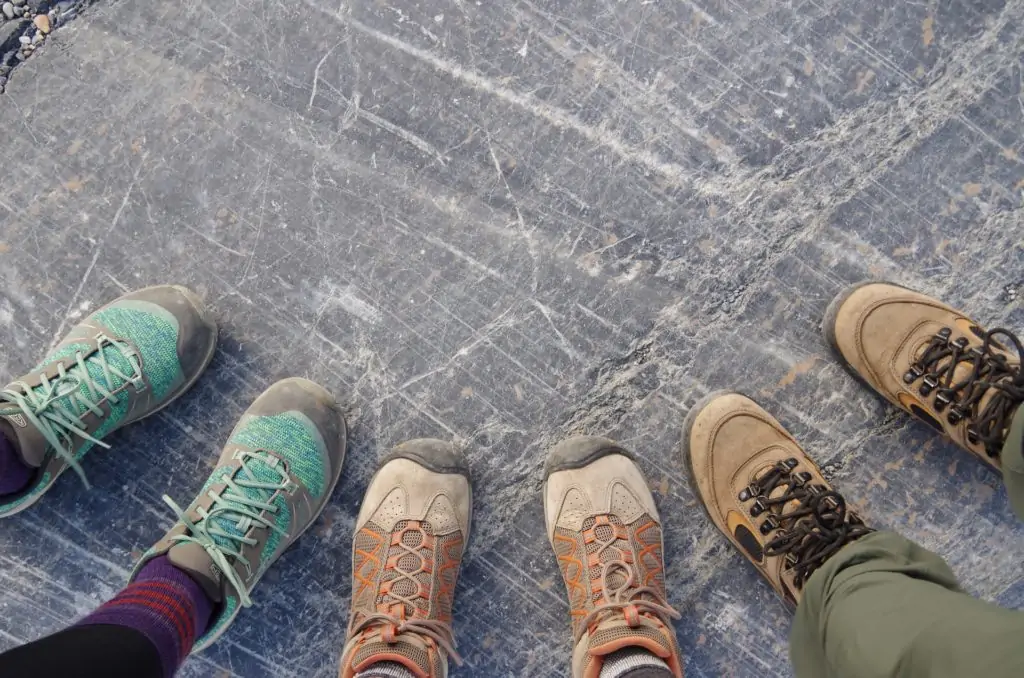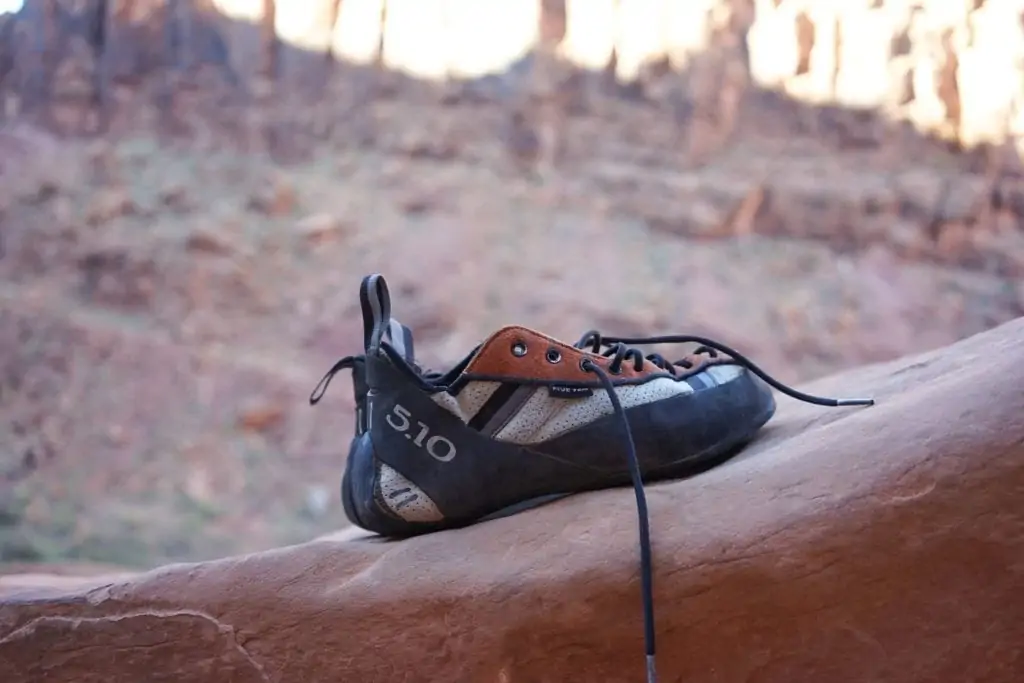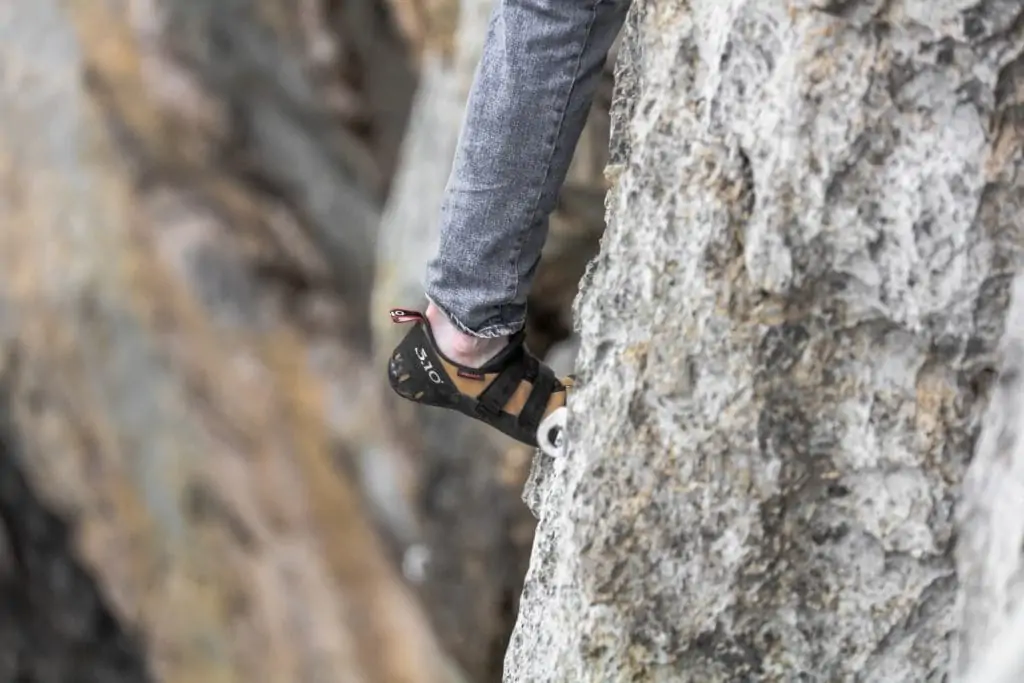Oh no! You just bought a brand new pair of climbing shoes, and they don’t feel right. Your toes are squished, and your feet are getting hot spots everywhere, but your friend told you that pain is the price for performance. It just doesn’t seem worth it. You think to yourself, can I stretch these shoes out?
This scenario plays out for so many climbers. If this sounds like you, don’t worry.
In this article, we’re going to break down stretching and fitting your climbing shoes. We’ll discuss everything from the type of material the shoe is made of to things to never do to your shoes and everything in between.
If you’re looking for information on how to shrink your climbing shoes, we wrote a post on that here.
 First Things First: Can You Stretch Climbing Shoes?
First Things First: Can You Stretch Climbing Shoes?
The answer depends on the type of shoes you own. Climbing shoes are all made with a rubber base and either a treated leather or synthetic body. The rubber base may stretch a small amount with increased wear, but nothing like the half-size stretch many people are looking for.
In general, leather shoes will stretch more than synthetic shoes, so if you just bought brand new synthetic shoes and you haven’t climbed in them yet, you should return them and go a size up. Leather shoes are going to be your best bet for successfully stretching a shoe.
The other part of stretching a shoe is the direction that needs to be stretched. If the shoe is too short for you, you should buy a size bigger. A shoe is not going to stretch noticeably in length, but if width or height is your problem, you may be able to stretch it out.
So say you decide that stretching your shoes might be your best option. Before you commit to stretching your new, likely quite pricey, climbing shoes, you may find yourself wondering how exactly they should fit.
How Uncomfortable Should Climbing Shoes Be?
Old-timers in climbing often tell newbies that pain is performance when it comes to climbing shoes. For many years, mangled toes as been viewed as a sign of a good day out climbing, but as new shoe designs continue to improve on both fit and performance of old shoes, this may be an outdated judge.
In general, it is best to have as little open air space as possible inside of your climbing shoes, as air spaces often lead to rubbing and hot spots. This means that climbing shoes should be snug, but not painful. Since there are so many brands making amazing climbing shoes, sometimes finding the right fit just involves lots of trying on shoes.
Try to look for shoes that fit your feet the best. If you have wide feet, try looking for wider or lace-up options. The more time you put into looking for the best fit in your climbing shoes, the less likely you will need to stretch your shoes after you buy them.
How Can You Stretch Climbing Shoes?
First, you need to decide how intense of a stretch you need in your shoes. Say one of your feet is a little bit bigger than the other, but nothing major. Maybe try a slow and gentle stretch. If your shoes are so tight that you can’t bare it, and you’ve already worn them outside, a more intense stretch may be what you’re looking for.
We have listed the stretching methods in a general order of least intense to most intense, so if you’re looking for the most intense stretch out there, option one may not be for you.
1. Wearing your shoes on a long climb.
Although it might be the most painful climb ever, the time-honored way of stretching out new climbing shoes is to take them out for a long and sweaty day of climbing. The sweat from your feet with moisten the shoes, loosening the leather just a little. After spending a long time climbing, or just on your feet in general, your feet will swell a little bit. However gross it may sound, the sweat combined with the slight swell may be enough to stretch your shoes a little bit.
2. Fill your shoes with plastic bags of water and freeze them.
Take sealable plastic bags and fill them with water before placing them into your shoes. The idea here is to recreate your feet, but with the water in the bags. It may be challenging, but try to fit the bags into your shoes as close as you can to the way your feet fit in the shoes. Then place your shoes, bags and all, into the freezer overnight.
As the water freezes, it will expand and stretch the leather of your shoe out, holding it there for an extended period of time. This method may take multiple nights of freezing to get it perfect, but for small adjustments, it may be perfect.
3. Put on thick socks inside your climbing shoes and then use a hairdryer to heat.
Find a thick pair of socks, the thicker the socks, the more potential stretching there is, and put them on inside of your climbing shoes. We know it will be really tight, given that your shoes were tight without the socks, but try your best. Then take a hairdryer and warm your feet, socks, and shoes together for a few minutes.
Be very careful if your shoes have metal parts, such as eyelets, so they don’t overheat and accidentally burn you. The heat loosens up the leather and makes it more pliable while the thick socks stretch it out. This method could also be done in stages, starting with thin socks and working up in thickness until you’ve stretched your shoes to perfection.
4. Soak your climbing shoes in a basin of hot water.
This one is sort of like a footbath for your shoes, just put on your shoes, fill up a basin with hot water, and soak your feet for a few minutes. When you take your feet out of the basin, wear your shoes around to dry them out some or all the way. If you take them off before they are totally dry, make sure to pack them with something to hold the shape, such as a few pairs of socks. This seems extreme, but the heat and moisture can really do some good for stretching out the leather.
5. Wear your climbing shoes into a hot shower.
We know this sounds strange, but hear us out. It’s just like the previous method, but you might feel a little silly standing in the shower wearing nothing but your climbing shoes. With that in mind, get ready to shower by putting on your shoes. Make sure the shoes get completely soaked with hot water before you get out. Like option four, either wear your shoes until they are dry or wear them until they are mostly dry and then pack them to hold the shape of your feet until they dry totally. You can also wait until they are just damp, put them back on your feet, and wear them climbing. After the initial stretch of heat and water, pushing the shoes through climbing while they are still damp ensures that they dry as stretched as you can get them.
With both option four and option five, your feet are likely to come out of your shoes slightly resembling your shoes in color. This is totally normal, the dye used to color the leather often bleeds the first few times it gets wet, so no worries. It might look odd to have blue, green, or red feet, but the color should wash and wear off pretty quick.
Is There Anything I Should Avoid When Stretching My Climbing Shoes?
So we have already established that both moisture and heat tend to be good for stretching out your shoes, but there is a limit to their abilities. Too much heat can melt the rubber on the sole of the shoe and deform the whole shoe, so it no longer fits any of your foot.
There is a theory floating around that if you put your shoes in the oven to heat them up and then put them on, that they will be more pliable and stretch more easily. This, however, could damage the shoes in so many ways. It is best to avoid putting your climbing shoes in the oven. Plus, its probably not worth the damage that it might cause to your oven.
Another thought people tend to have when thinking about heating things up is to use the microwave. This is a slower heat that won’t get hot enough to melt the rubber, unless you leave your shoes in for a crazy long time, but it does pose other risks. Many climbing shoes have some metal parts, typically in the eyelets of the shoe, and these parts run the risk of sparking if put in the microwave.
Similar to the oven problem, the amount of damage to both your shoes and your microwave is just not worth it to use this to try to heat your shoes up.
We recommend you stick to using a hairdryer (very carefully) or hot water as they won’t damage the material and structural integrity of the shoes.
Do Shoe Stretchers Work for Climbing Shoes?
There are commercial shoe stretchers out there. They are chunks of wood that can be screwed farther apart or closer together to hold the shoe in a particular shape. Generally, these commercial shoe stretchers are not shaped for climbing shoes, so they aren’t likely to fit into your shoes the same way your feet would.
If you have climbing shoes with a minimal arch (think the La Sportiva Trantulace) and you only need to stretch the toe box, then wetting your shoes with a basin of hot water or in a hot shower and then allowing them to dry on a shoe stretcher would probably be helpful.
The main challenge with the shoe stretchers is that they still need something else to help them stretch the leather used to make climbing shoes, be it moisture or heat. They also don’t conform to the same aggressive arch shape of many performance-oriented shoes, so you run the risk of stretching your shoes in a direction that you didn’t want to stretch your shoes in.
Again, the end goal of a well-fitting climbing shoe is to have the shoes conform to your foot and leave the least amount of air space while not harming your feet. The shoe stretcher is not likely to achieve this.
Wrapping Things Up: Key Takeways on Stretching Your Climbing Shoes
So overall, you can stretch your climbing shoes, provided that they are leather and not synthetic.
Although it’s technically possible to stretch your climbing shoes, it will take time, and you still may not achieve your desired end result if the shoes you bought just aren’t the right shape for your feet.
The best option with climbing shoes is to dedicate a large amount of time to finding the perfect style and fit of shoes for your feet. That way, you won’t have to spend the time even trying to stretch them. So go out and try on some new shoes!
If you enjoyed this post, check out our other climbing tips here. And like we mentioned, if you want to shrink your shoes, check out our post on shrinking climbing shoes here.

 First Things First: Can You Stretch Climbing Shoes?
First Things First: Can You Stretch Climbing Shoes? 








